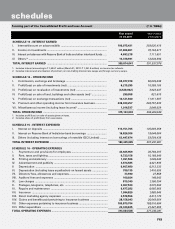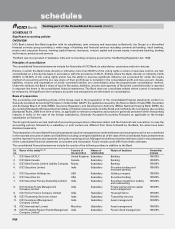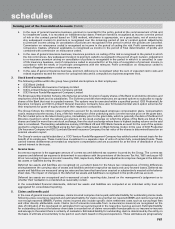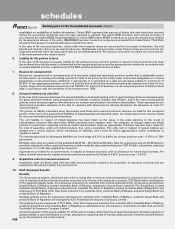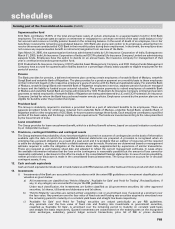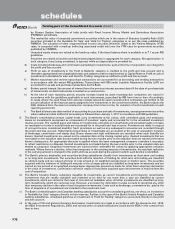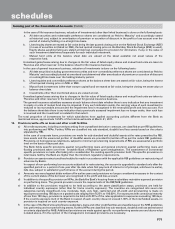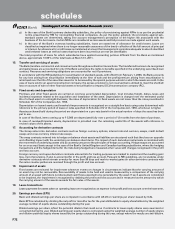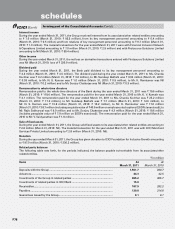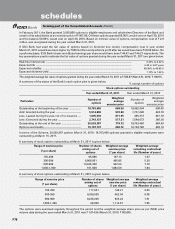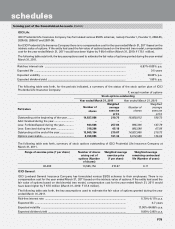ICICI Bank 2011 Annual Report Download - page 150
Download and view the complete annual report
Please find page 150 of the 2011 ICICI Bank annual report below. You can navigate through the pages in the report by either clicking on the pages listed below, or by using the keyword search tool below to find specific information within the annual report.
F72
g) In the case of the Bank’s primary dealership subsidiary, the policy of provisioning against NPAs is as per the prudential
norms prescribed by RBI for non-banking financial companies. As per the policy adopted, the provisions against sub-
standard assets are determined, taking into account management’s perception of the higher risk associated with the
business of the borrowers. Certain NPAs are considered as loss assets and full provision is made against such assets.
h) In the case of the Bank’s overseas banking subsidiaries, loans are stated net of allowance for credit losses. Loans are
classified as impaired when there is no longer reasonable assurance of the timely collection of the full amount of principal
or interest. An allowance for credit losses is maintained at a level that management considers adequate to absorb identified
credit related losses as well as losses that have been incurred but are not yet identifiable.
The total proportion of loans for which subsidiaries have applied accounting policies different from the Bank as mentioned
above, approximate 13.00% of the total loans at March 31, 2011.
15. Transfer and servicing of assets
The Bank transfers commercial and consumer loans through securitisation transactions. The transferred loans are de-recognised
and gains/losses are accounted for only if the Bank surrenders the rights to benefits specified in the underlying securitised loan
contract. Recourse and servicing obligations are accounted for net of provisions.
In accordance with the RBI guidelines for securitisation of standard assets, with effect from February 1, 2006, the Bank accounts
for any loss arising from securitisation immediately at the time of sale and the profit/premium arising from securitisation is
amortised over the life of the securities issued or to be issued by the special purpose vehicle to which the assets are sold. In the
case of loans sold to an asset reconstruction company, the excess provision is not reversed but is utilised to meet the shortfall/
loss on account of sale of other financial assets to securitisation company (SC)/reconstruction company (RC).
16. Fixed assets and depreciation
Premises and other fixed assets are carried at cost less accumulated depreciation. Cost includes freight, duties, taxes and
incidental expenses related to the acquisition and installation of the asset. Depreciation is charged over the estimated useful
life of a fixed asset on a straight-line basis, the rates of depreciation for fixed assets are not lower than the rates prescribed in
Schedule XIV of the Companies Act, 1956.
Depreciation on leased assets and leasehold improvements is recognised on a straight-line basis using rates determined with
reference to the primary period of lease or rates specified in Schedule XIV of the Companies Act, 1956, whichever is higher.
Assets purchased/sold during the period are depreciated on a pro-rata basis for the actual number of days the asset has been
put to use.
In case of the Bank, items costing up to ` 5,000 are depreciated fully over a period of 12 months from the date of purchase.
In case of revalued/impaired assets, depreciation is provided over the remaining useful life of the assets with reference to
revised values of the assets.
17. Accounting for derivative contracts
The Group enters into derivative contracts such as foreign currency options, interest rate and currency swaps, credit default
swaps and cross currency interest rate swaps.
The swap contracts entered into to hedge on-balance sheet assets and liabilities are structured such that they bear an opposite
and offsetting impact with the underlying on-balance sheet items. The impact of such derivative instruments is correlated with
the movement of underlying assets and accounted pursuant to the principles of hedge accounting. Hedge swaps are accounted
for on an accrual basis except in the case of the Bank’s United Kingdom and Canadian banking subsidiaries, where the hedging
transactions and the hedged items (for the risks being hedged) are measured at fair value with changes recognised in the profit
and loss account.
Foreign currency and rupee derivative contracts entered into for trading purposes are marked to market and the resulting gain/
loss, (net of provisions, if any) is accounted for in the profit and loss account. Pursuant to RBI guidelines, any receivables under
derivative contracts which remain overdue for more than 90 days and mark-to-market gains on other derivative contracts with
the same counter-parties are reversed through the profit and loss account.
18. Impairment of assets
Fixed assets are reviewed for impairment whenever events or changes in circumstances indicate that the carrying amount of
an asset may not be recoverable. Recoverability of assets to be held and used is measured by a comparison of the carrying
amount of an asset with future net discounted cash flows expected to be generated by the asset. If such assets are considered
to be impaired, the impairment is recognised by debiting the profit and loss account and is measured as the amount by which
the carrying amount of the assets exceeds the fair value of the assets.
19. Lease transactions
Lease payments for assets taken on operating lease are recognised as an expense in the profit and loss account over the lease term.
20. Earnings per share (EPS)
Basic and diluted earnings per share are computed in accordance with AS 20 on ‘earnings per share’ issued by ICAI.
Basic EPS is calculated by dividing the net profit or loss after tax for the year attributable to equity shareholders by the weighted
average number of equity shares outstanding during the year.
Diluted earnings per share reflect the potential dilution that could occur if contracts to issue equity shares were exercised or
converted during the year. Diluted earnings per equity share is computed using the weighted average number of equity shares
and dilutive potential equity shares issued by the group outstanding during the year, except where the results are anti-dilutive.
forming part of the Consolidated Accounts (Contd.)forming part of the Consolidated Accounts (Contd.)
schedules



